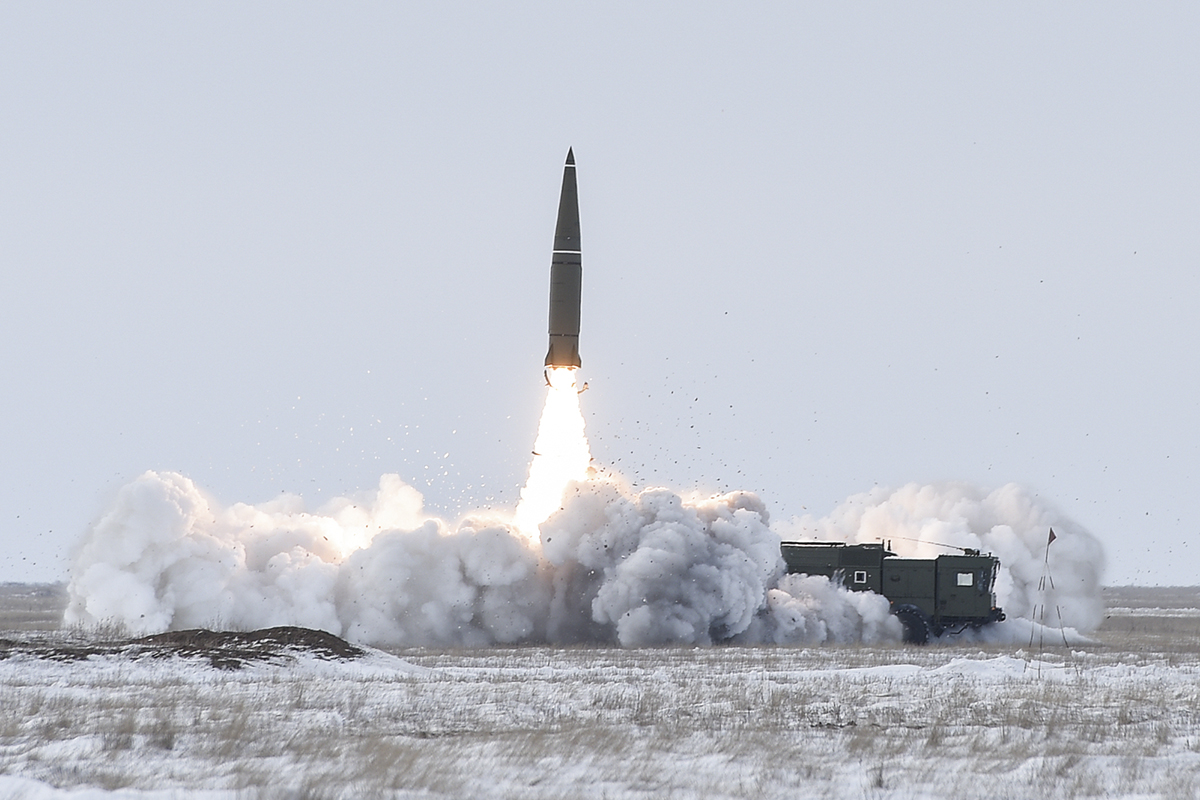Russian Iskander-M short-range ballistic missiles (SRBM) are releasing a previously unknown decoy, designed to evade air-defense systems, The New York Times reported quoting US intelligence officials.
Russian Navy Joins Invasion! Images Of Amphibious Warship Arriving In Seized Ukrainian Port City Go Viral
Earlier, American officials had assessed that the Iskander-M will be a key weapon system that Russia would use to “destroy vital objects” during its military operation against Ukraine.
According to the Ukrainian Ministry of Defense, a total of 36 Iskander launchers were deployed by the Russian armed forces close to the border and Ukraine’s capital Kyiv. Key Ukrainian military installations were within the strike range of these missiles.
Now, US intelligence officials have learned that the ballistic missiles fired by Russia into Ukraine have decoys that can evade air-defense radars and trick heat-seeking missiles.

“Each is packed with electronics and produces radio signals to jam or spoof enemy radars attempting to locate the Iskander-M, and contains a heat source to attract incoming missiles,” a US official told NYT.
These dart-shaped white-colored decoys are about a foot long each, with an orange tail. American sleuths are of the view that the Iskander-Ms fired from mobile launchers across the border release these decoys when they sense that they have been targeted by the Ukrainian air defenses.
Powered by a solid-fuel rocket motor, Iskander is capable of reaching targets as far as 500 km away with a circular error probability (CEP) of 5-7 meters, which means half of the projectiles fired will land in a circle with a radius of that size.
According to the US-based Center for Strategic and International Studies (CSIS), the Iskander projectiles are designed in such a way that they can confuse missile defenses by flying on a low trajectory and maneuvering their flight.
Each mobile launcher can fire two Iskanders before it must be reloaded and has an armored cover for the missiles, and its cabin is hardened against chemical, biological, radiological, and nuclear hazards, as well as extreme temperatures.
This is an unidentified munition currently being found in Ukraine. At the moment an official identification has not been made. Any additional images, technical information or identification is very much appreciated: https://t.co/dtWwdIJaV3 pic.twitter.com/p2lWFeljYd
— CAT-UXO (@CAT_UXO) March 5, 2022
Reports suggest that as of March 1, Russia had fired about 320 missiles into Ukraine, the majority being Iskander SRBMs.
“Russia most likely used its only SRBM in active service, the Iskander-M”, said Timothy Wright, a research analyst with the International Institute for Strategic Studies (IISS).
What the missiles targeted and how much damage they caused remains unclear amid the confusion of the developing war, but according to reports, Iskanders were used to attack Ukrainian airbases.
Powerful Tochka-U Missile ‘Shot-Down’ Mid Air Over Donetsk; Its Debris Kills Scores In The Region
Ukrainian Airbase Destroyed
Iskander missiles launched from Belarus had successfully hit an airport in Zhytomyr in northern Ukraine on March 13, an adviser to Ukraine’s interior minister said.
“We see some damage at airports, and it looks fairly accurate,” said Jeffrey Lewis, a missile researcher at the James Martin Center for Nonproliferation Studies (CNS).
The use of decoys may have been the reason behind why the Ukrainian air-defense weapons have been unable to intercept Russia’s Iskander missiles.
Satellite imagery from @planet comparing between Feb 22 and Feb 27 shows multiple impact points of rocket attacks on Ozerne Airbase in Zhytomyr Oblast, Ukraine. Location: 50.159545, 28.745068 pic.twitter.com/cWL56u2pOC
— Centre for Information Resilience (@Cen4infoRes) February 28, 2022
Images of the dart-shaped munitions started circulating on social media two weeks ago. At the time, experts and open-source intelligence (OSINT) analysts had thought that these were bomblets from cluster weapons, based on their size and shape.
Richard Stevens, a British Army veteran who served 22 years as an explosive ordnance disposal soldier, and later worked as a civilian bomb technician for 10 years in southern Iraq, Africa and other regions, said he had been exposed “to plenty of Chinese and Russian munitions, but I had never seen this”.
He posted photos of the munitions to a site for military and civilian bomb disposal experts that he started in 2011, and found that nobody else seemed to have seen these munitions before either.
The US intelligence officials told NYT that these devices are similar to Cold War-era decoys called “penetration aids” that have accompanied nuclear warheads since the 1970s and were designed to evade anti-missile systems so as to allow individual warheads to reach their targets.
However, the use of decoys on missiles like Iskander-M that have conventional warheads has not been previously documented by military experts.
According to Jeffrey Lewis, these decoys are not easily seen because they are highly secret and it is highly unlikely that the version of the Iskander that Russia has sold to other countries would contain these decoys.
“Russia knows they will inevitably be collected and studied by Western intelligence services so that NATO air defenses can be programmed to defeat the Iskander’s countermeasures,” Lewis said.
“That suggests to me that the Russians place some value on keeping that technology close to home and that this war is important enough to them to give that up,” Lewis added. “They’re digging deep, and maybe they no longer care, but I would care if I were them.”
- Written by Tanmay Kadam/EurAsian Times Desk
- Contact the author at etdesk@eurasiantimes.com
- Follow EurAsian Times on Google News